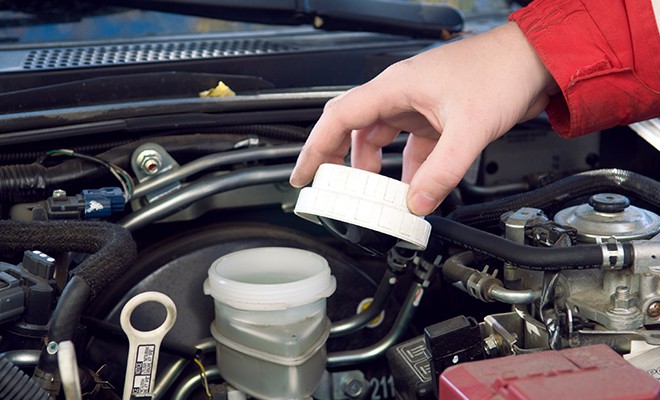WHAT DOES BRAKE FLUID DO?
Playing a crucial role in the braking process, brake fluid helps transfer the movement and force created when you press down on the brake pedal. Extreme heat is generated when braking. This high heat can cause moisture to condense in the brake hydraulic system.
The brake fluid absorbs this moisture and prevents it from boiling and causing brake failure. In addition, the brake fluid serves as a lubricant for all movable parts and prevents corrosion. It must remain fluid in all temperatures.
Brake fluid helps transfer the movement and force created when you press down on the brake pedal.
Adding brake fluid is usually not part of routine vehicle maintenance. Low brake fluid typically means that your brake pads are worn and will soon need to be changed. If you notice a sudden drop in the brake fluid level, it could indicate a problem with your brake system or that you simply need to change your brakes. Have a mechanic check your brakes if you are unsure.
Dot brake fluid types
The four types of brake fluid available are:
- DOT 3
- DOT 4
- DOT 5
- DOT 5.1
*DOT 3 and DOT 4 and DOT 5.1 are glycol-based fluids. DOT 5 is silicone-based. The main difference is that DOT 3 and DOT 4 and DOT 5.1 absorb water, while DOT 5 doesn't.
WHAT DOES DOT STAND FOR?
DOT stands for Department of Transportation. The DOT placed regulations regarding specifications for brake fluid to be used in automobiles in the US. This is to ensure a standard quality of product for everyone's safety.
BRAKE FLUID FACTS
- Never use DOT 5 fluid in a vehicle that uses DOT 3 or DOT 4
- You can use DOT 4 in a car that uses DOT 3, but NOT vice-versa
- Never substitute any other fluid for brake fluid
- Do not spill brake fluid - it damages painted surfaces and finishes
- Wash your hands after coming in contact with brake fluid
- DOT 5 doesn’t mix well with glycol fluids in cars with ABS brakes
What Brake Fluid to Use?
The best way identify what type of brake fluid your car needs is to check your owner's manual. You can also check the master cylinder reservoir cap to identify the type of brake fluid used in your vehicle.
HOW TO ADD BRAKE FLUID

- Determine the location of the brake fluid reservoir
- Look inside the reservoir to determine the current fluid level. If it's at the "full" mark, close the reservoir and mark the date of the inspection in your maintenance log.
- If the fluid level is below the "add" line, have your disc brakes checked. As disc brakes wear down, the fluid is displaced into the brake calipers. Most brake fluid reservoirs are designed so you should not have to add or "top off" the fluid. If the fluid looks dark, have a mechanic test and inspect the fluid.
Learn more about Wagner brake fluid, find your car part, or find where to buy your auto part today.
The content contained in this article is for entertainment and informational purposes only and should not be used in lieu of seeking professional advice from a certified technician or mechanic. We encourage you to consult with a certified technician or mechanic if you have specific questions or concerns relating to any of the topics covered herein. Under no circumstances will we be liable for any loss or damage caused by your reliance on any content.